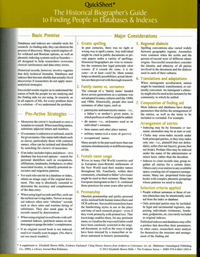
|
|
|
| Product Information: | ||
| Details: | QuickSheet: The Historical Biographer’s Guide to Finding People in Databases & Indexes; by Elizabeth Shown Mills; 4 pp; 2012; Laminated, folded sheet; ISBN: 9780806318936; 8.5x11; Item # GPC3869 The premise of this QuickSheet is that while databases and indexes are valuable tools for research, they can actually impede the research process. We all know that databases and indexes can shortcut the process of discovery, and many search engines offer wildcard and Boolean options, as well as phonetic indexing systems to help researchers contend with clerical carelessness and data-entry errors. But historical records involve vagaries that defy technical formulas. Databases and indexes then become obstacles that actually block discoveries. Enter Elizabeth Mills, who in this QuickSheet shows how to adopt pro-active strategies to overcome this problem and thus get the full benefit of databases and indexes. Confronting the problem head-on she first identifies a number of typical weaknesses--erratic spelling, family names as surnames, female name usage, penmanship, regional dialects, transcription and translation, and arbitrary selection criteria. Along with these considerations she spells out a number of specific strategies ranging from searching for given names among clusters of associates to substituting adjacent letters and numbers on a typewriter keyboard. Three of the four laminated pages of this QuickSheet are then given over to a table of common anomalies and errors, with columnar listings of anomaly types, typical problems, and examples. Anomaly types, covering almost every erratic feature, include abbreviations, spelling issues, prefixes, handwriting, language, dialects, sorting errors, typing errors, and translated names. Corresponding columns then provide listings of typical problems, and, most helpfully, extensive examples of common problems and their likely solutions. This is a very handy feature when you hit a roadblock in your research.
|
|

